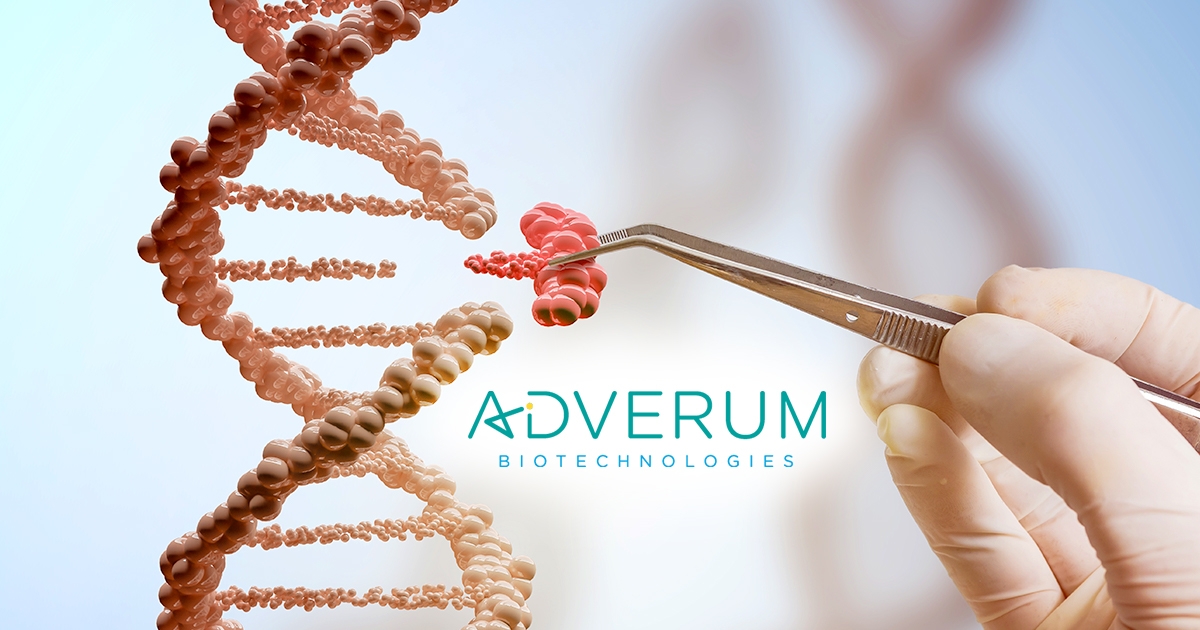Adverum, Gene Therapy, and AMD

Adverum, a company pioneering novel gene therapies for ocular diseases, believes a gene therapy treatment for wet age-related macular degeneration (AMD) can reduce treatment burden and help patients maintain better vision, compared with intravitreal injection. Their lead product candidate, ADVM-022, is designed to do just that, and possibly take a piece of the $6.9 billion AMD market. (Estimates suggest the market may reach $10.4 billion by 2024.1)
The unmet need
Although anti-vascular endothelial growth factor (VEGF) therapies have been successful, real world outcomes don’t match clinical trial results and are not sustainable over the longer term. When injection frequency drops, as it often does due to patient burden, the gains are far less than what is achieved under perfect clinical trial conditions — which Adverum believes opens a door for a completely different type of treatment, according to Adverum’s chief medical officer Aaron Osborne, MBBS.
“A very important point,” he said, “is that wet AMD is a lifelong disease. The goal is to preserve vision until patients reach the end of their lives.”
The technology solution
Adverum researchers chose to develop a treatment that utilizes an intravitreal approach rather than a subretinal one. They believe this approach offers significant advantages, most importantly that it can be applied to a much broader patient population. It can also be done as an outpatient procedure rather than needing a surgery setting, and there are safety advantages as well. And it’s known that intravitreal delivery of anti-VEGF agents is effective, in a situation where VEGF is a secreted protein.
ADVM-022 is specifically designed for long-term intraocular VEGF suppression with a single intravitreal injection. It utilizes Adverum’s AAV.7m8 capsid platform and capabilities, and was developed using directed evolution—initially at UC Berkeley and then at Adverum—specifically to enable efficient intravitreal delivery, increase transduction of retinal cells, and increase protein expression.
Early data
Preclinical data has demonstrated the potential for long-term efficacy with a single intravitreal injection of ADVM-022. The results showed that aflibercept protein expression was sustained at pharmacologically relevant levels through 30 months, and that ADVM-022 given 13 months prior to laser is as effective as aflibercept at the time of laser.
OPTIC trial
The OPTIC trial is an ongoing phase 1 first-in-human trial looking at ADVM-022 in patients who require frequent intravitreal injections to maintain their vision. Dosing of cohorts 1 and 2 is completed, while cohort 3 is enrolling and cohort 4 screening has been started. The primary aim of the study is to establish safety and tolerability, while the secondary aim is to evaluate vision and assess the need for anti-VEGF injections. In cohort 1, 6 of 6 patients remained rescue-injection-free at a median follow up of 50 weeks, with 3 patients at 52 weeks. In cohort 2, 4 of 6 patients remained rescue injection free at 24 weeks, and in both cohorts, 10 or 12 patients (83%) remained rescue-injection free. Through 6 months, visual acuity was stable on average, and improvement (reduction) in central retinal subfield thickness was seen in cohorts 1 and 2. Five of six subjects showed complete anatomic response. Cohorts 3 (n=9, three-fold lower dose compared to cohort 1, 2 x 10^11 vg/eye) of the OPTIC Phase 1 clinical trial of ADVM-022 in wet age-related macular degeneration (wet AMD). Cohort 4 is enrolling up to 9 patients and will dose at 6 x 10^11).
Moving Forward
Dr. Osborne says the company is a “science-driven company with a robust patent portfolio,” a scalable manufacturing process, and a leadership team with extensive ophthalmology experience. He says they’re “well capitalized” with $162.0 million in cash.
In the company’s Q3 2019 earnings call, president, CEO, and director Leone Patterson said significant progress has been made over the past year with ADVM-022, with positive data from the first cohort of six patients in the OPTIC trial, completion of enrollment in cohort 2, and plans to dose additional patients in the third and fourth cohorts. Ms. Patterson said the current data, which are being presented at various congresses, show that durable efficacy with a median follow-up of 34 weeks was generally safe and well tolerated with no SAEs, and no patient received a rescue injection.
Dr. Osborne said, “These promising data are important as they demonstrate ADVM-022 may provide a single injection option for patients who would otherwise require frequent injections to manage their wet AMD.”
The company is also developing ADVM-022 for a second indication, diabetic retinopathy, with a planned IND submission in the first half of 2020. Dr. Osborne pointed out that of the estimated 8 million people living with diabetic retinopathy in the U.S., only 2 million are diagnosed and only 1 million are being treated.
“We believe maintaining consistent levels of VEGF suppression with ADVM-022 could be particularly important for this rapidly progressing disease, potentially improving treatment outcomes over currently available therapies,” he said.
Reference:
1. Wet Age-Related Macular Degeneration Market by Product, by Distribution Channel, by Age Group, by Route of Administration, by End User, by Geography Global Market Size, Share, Development, Growth, and Demand Forecast, 2014-2024. Available at: https://www.prnewswire.com/news-releases/wet-age-related-macular-degeneration-market-by-product-by-distribution-channel-by-age-group-by-route-of-administration-by-end-user-by-geography-global-market-size-share-development-growth-and-demand-forecast-2014-2024-300955371.html. Accessed March 16, 2020.
